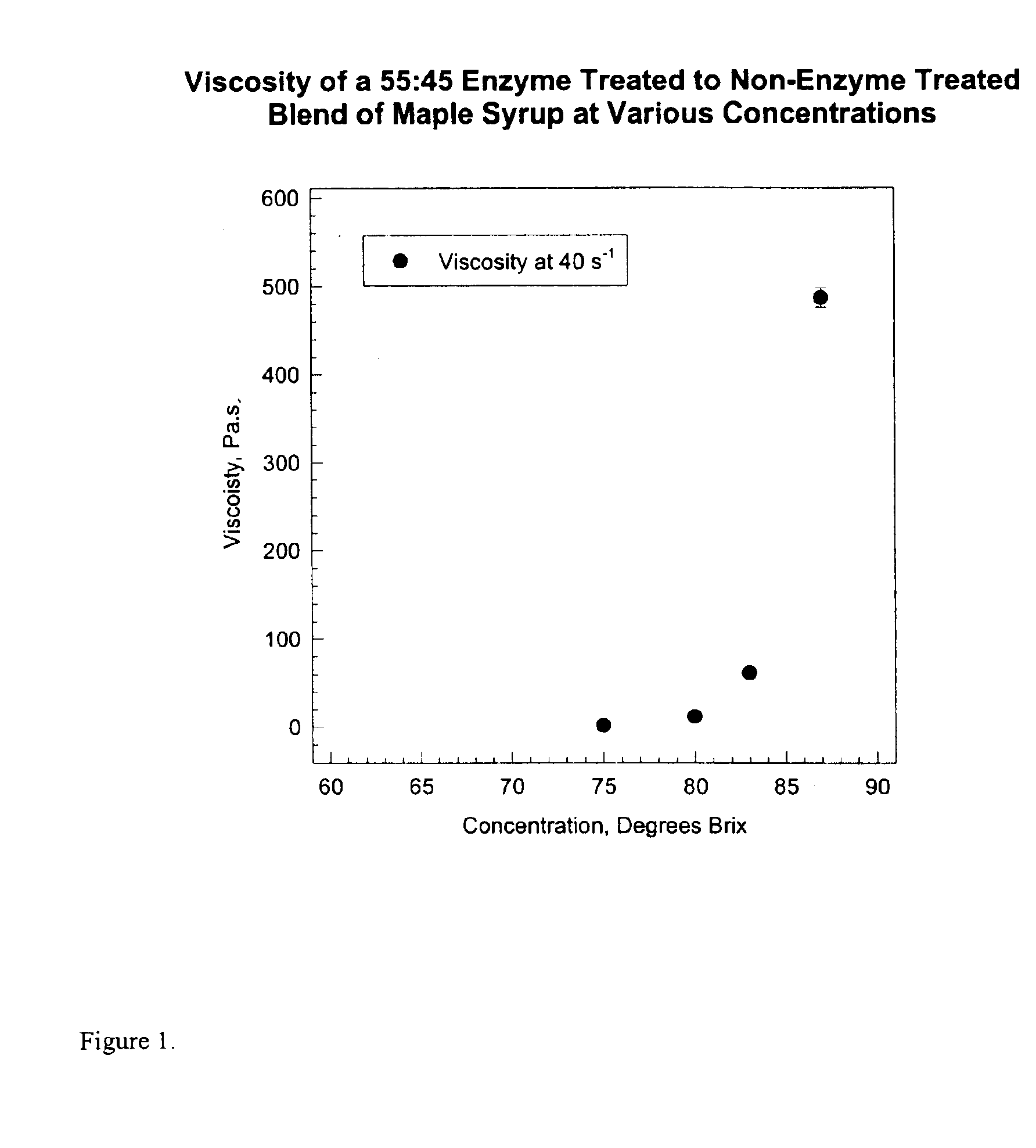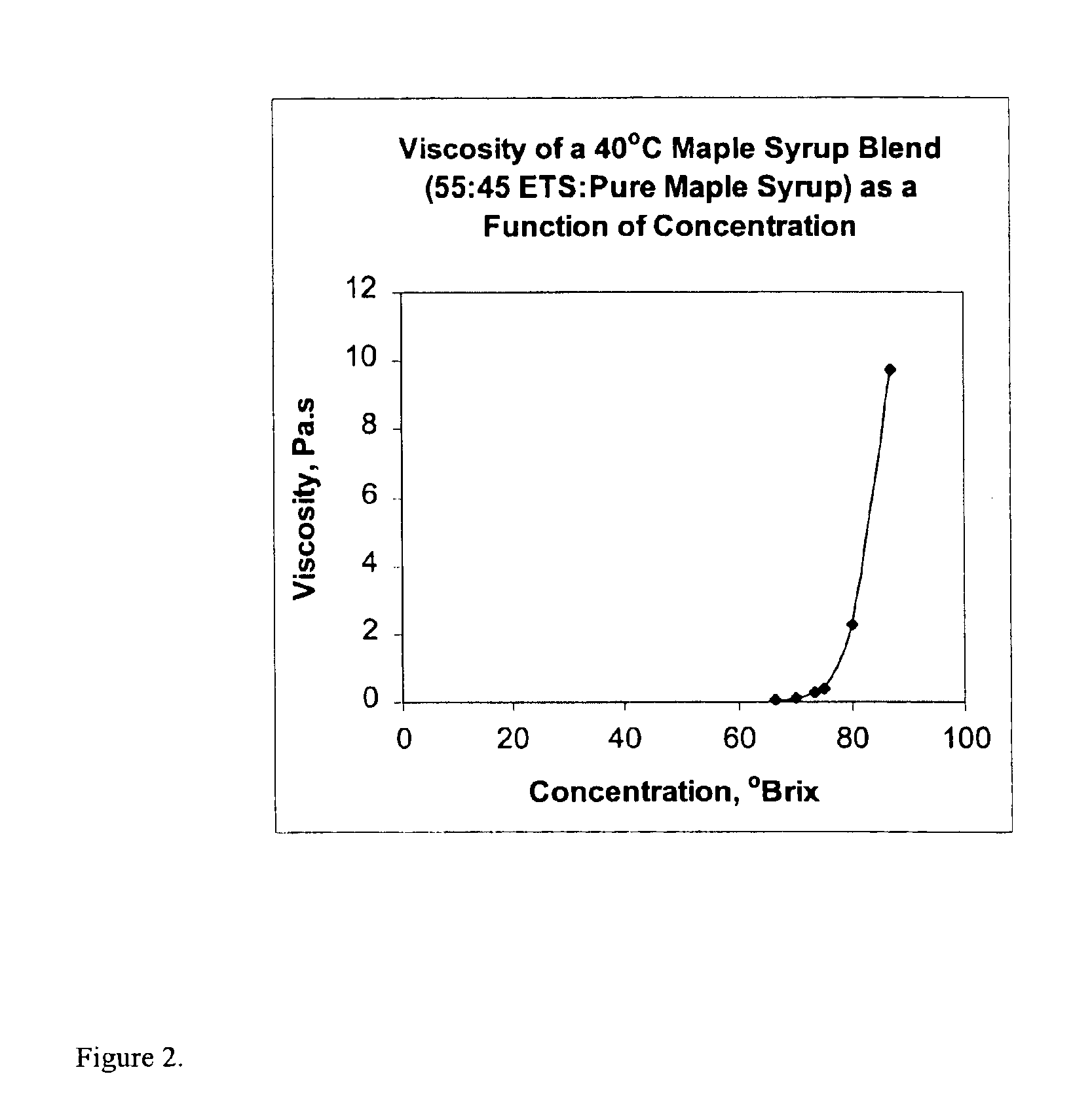Enzyme treated maple syrup and shelf stable products containing enzyme treated maple syrup
a technology of enzyme treatment and maple syrup, which is applied in the field of enzyme treatment maple syrup and shelf stable products containing enzyme treatment maple syrup, can solve the problems of product sour taste, small crystals, and inability to simply use stabilizers, and achieve the effects of enhancing shelf stability, and preventing the visible crystallization or separation of maple based products
- Summary
- Abstract
- Description
- Claims
- Application Information
AI Technical Summary
Benefits of technology
Problems solved by technology
Method used
Image
Examples
example 1
Addition of Invert Sugar to Maple Syrup
[0074]The first stabilization technique evaluated was simple addition of invert sugar (glucose and fructose) to maple syrup and then concentrating to 82 degrees Brix on a hot plate. Four different levels of invert sugar were added: 1, 6, 10, and 20 percent. Crystallization was evident in all samples within three weeks of storage at room temperature. Interestingly, the more invert sugar added, the longer the time before crystallization was evident. However, with increasing invert sugar content, the maple flavor decreased substantially. The type of invert sugars was also evaluated. Three different invert sugars, solid invert, medium invert and high fructose corn syrup, were added at 20 percent of the total volume to 66 degrees Brix maple syrup and concentrated to 80 to 82 degrees Brix. Crystallization appeared in each of the samples within about three weeks.
example 2
Addition of Cream of Tartar to Maple Syrup
[0075]Cream of tartar (L-Tartaric Acid, Sigma Chemicals, Oakville, ON, Canada.) is an accepted way of converting sucrose to glucose and fructose (North American Maple Producers Manual s.7). Three levels of tartaric acid were evaluated: 0.02, 0.08 and 0.10 percent. Tartaric acid was added to the 66 degrees Brix maple syrup. The solution was heated to boiling, as it was thought that the heat added in concentrating the syrup to 80-82 degrees Brix was thought to be sufficient to cleave a portion of the sucrose to glucose and fructose. However, the resultant samples were very bitter in taste and had a distinct hazy appearance. All samples also crystallized after a two-day period at room temperature.
example 3
Enzymatic Cleavage of Sucrose to Glucose and Fructose with pH Adjustment
[0076]The enzyme invertase (Sigma Chemicals, Oakvill ON, Canada) was used to cleave sucrose to glucose and fructose. The optimal pH for this specific invertase enzyme is 4.5. However, the natural pH of maple syrup is 6.8. the first trial, 1 kg of maple syrup was placed in a sterile container. The pH of the maple syrup was adjusted to 5.0 using tartaric acid, closer to the optimal pH of the enzyme. To this, enzyme was added (1 g enzyme per 500 g syrup). In order to assist in the dispersion of the enzyme, the maple syrup was diluted to 55 degrees Brix using sterile deionized water. The solution was divided into two portions with one portion incubated at room tempera re (22 to 23 degrees Celsius) and the other was incubated at 33 degrees Celsius. After 6 day incubation period the sucrose, glucose and fructose content was determined using HPLC methods (AOAC Official Method 977.20, Separation of Sugars in Honey). At ...
PUM
| Property | Measurement | Unit |
|---|---|---|
| boiling point | aaaaa | aaaaa |
| transparent | aaaaa | aaaaa |
| viscosity | aaaaa | aaaaa |
Abstract
Description
Claims
Application Information
 Login to View More
Login to View More - R&D
- Intellectual Property
- Life Sciences
- Materials
- Tech Scout
- Unparalleled Data Quality
- Higher Quality Content
- 60% Fewer Hallucinations
Browse by: Latest US Patents, China's latest patents, Technical Efficacy Thesaurus, Application Domain, Technology Topic, Popular Technical Reports.
© 2025 PatSnap. All rights reserved.Legal|Privacy policy|Modern Slavery Act Transparency Statement|Sitemap|About US| Contact US: help@patsnap.com


